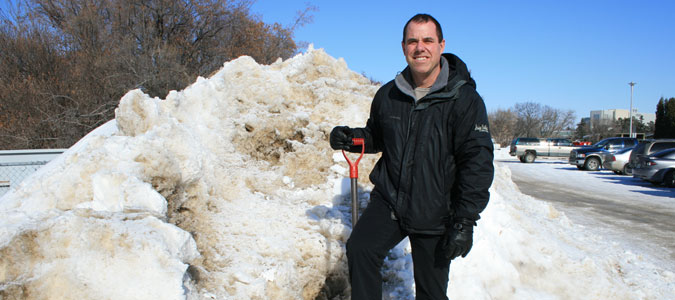The snow man
Even though Darren Crilly is busy planning spring and summer landscaping projects on the U of S campus, winter is never far from his thoughts, particularly this year.
By Kris Foster That's because the grounds manager and his crew of 15 supervisors, equipment operators and shovellers from the Facilities Management Division (FMD) are responsible for clearing the snow from 25 kilometres of roads and pedestrian paths as well as from in and around over 350 doorways. And with the near-record amount of snow that has blanketed campus so far this winter – well over 110 cm according to city statistics – it has been a mammoth task.
That's because the grounds manager and his crew of 15 supervisors, equipment operators and shovellers from the Facilities Management Division (FMD) are responsible for clearing the snow from 25 kilometres of roads and pedestrian paths as well as from in and around over 350 doorways. And with the near-record amount of snow that has blanketed campus so far this winter – well over 110 cm according to city statistics – it has been a mammoth task.
Preparation for snow removal begins months before the first flake falls. During the summer, Crilly prioritizes areas of campus for snow clearing, knowing it takes several days to shovel everywhere after an average snowfall. Topping the list are the most heavily used roads and pathways like those around the Bowl, in the bus terminal area and the Wiggins sidewalk leading to campus. Other priority areas include loading docks, sidewalk and building ramps, and parking spots for people with disabilities. "The lesser-used paths may be cleared at the end of a five-day run," he said.
While the FMD crew does use front-end loaders and Bobcats for the big stuff and smaller machines for brushing or plowing walkways, there is a still lot of snow that has to be cleared by hand, he said. And the favourite tool for the job is a 24-inch plastic shovel with a wooden handle.
"People know how much shovelling they've had to do around their own homes this winter," said Crilly. "Now imagine putting in six or seven hours a day shovelling for five days straight. It's a big, big job, often in trying conditions. The frequency of snowfalls this year has made it very difficult but everyone continually rises to the challenge."
Snow clearing on roadways and in parking lots is handled by heavy equipment contractors. Crilly said part of his preparation for winter is negotiating contracts for complete snow removal from these areas, which, "if everything goes well, is a five-night process after a good heavy dump of snow." With the contacts in place, he then waits for the snow to arrive.
"As soon as five centimetres fall, I start thinking contractors but when you pick up the phone and make that call, it can cost anywhere from $12,000 to $40,000, depending on what you need so I take it very seriously."
Crilly said his budget typically covers three complete snow lifts by contractors from roads and parking lots per winter but this year, "we're about double that number." Particularly frustrating has been the frequency of the snowfalls this year, he said. "You get halfway through and it snows again. Then you're right back at the start."
The snow crew also spreads gravel on known slippery areas around campus including stairs and ramps, "but we don't sand every single pathway. You have to remember that every grain of gravel we spread in winter has to be picked up in the spring because it can clog sprinklers and damage landscaping." Crilly pointed out there are brown self-serve gravel boxes strategically placed around campus that people can use to improve their traction.
He readily admits snow clearing on campus is challenging, and there are complaint calls but "a lot of times, it's a legitimate issue and we just didn't see it or hadn't got to it." That said, he has a couple of pointers for members of the campus community.
The first is to have proper winter footwear because sidewalks and roads do get icy in winter – "high-quality rubbersoled shoes or boots give you the best traction." He also encourages people to be aware of snow clearing operations.
"Students and staff on foot are often impatient around our equipment. We ask people to be as understanding as possible and give them the room they need to do their work."
The end of this year's snowfall may well be in sight but the inevitable issues of melting are still to come. Snow piles are being moved to a dump on the north edge of campus, he said, and work has started on clearing snow and ice from around catch basin drains and in flood-prone areas of campus. So there are a few more weeks of winter work before the grounds manager can turn his full attention to the green seasons at the U of S.

